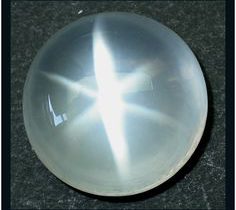Metamorphosis Quartz by Bob Jackson
Metamorphosis Quartz by Bob Jackson
This clear to opaque milky quartz has been available for several years. In review, it is
- the precursor for “Oro Verde” (after irradiation with 0.3 MEV gamma)
- utilized for spheres due to opalescence somewhat like the Girasol opal from Madagascar and more recently,
- shaped into cabochons to achieve possible asterism/cateye effects (about 5% of the mine runs material).
The designation “Meta quartz” was originally coined because of the change due to irradiation. Subsequently, it was observed that the rough material would slowly change to smoky or rose quartz over a period of 306 months upon exposure to sunlight or incandescent light. I continue to work with the material and am continually discovering unique optical effects.
The quart has a needle type inclusion. The needles appear to be randomly distributed on the macro level in the massive material. On the micro level; the needles seem to group in seams, which vary in extent and in orientation. This seam arrangement permits shaping cabochons with asterism. Analyses have not established the identity of the material compromising needles. The needles (individually and collectively) exhibit a light transmitting quality (fiber optic) and a slight but, interest light amplification effect. These properties coupled with the random distribution of this seams of needles produces a range of light reflecting and optical effects depending on the quality of the rough and subsequent shaping and polishing.
In the past, “star” quartz (with the exception of various “rose” quartz material) has been uncommon. The two notable (to me) examples, from Sri Lanka and Alabama, were notably low production; neither was available in significant quantity. The “Meta” quartz production has exceeded multi-ton quantities. Three mines in North Mineas Gerais are the sole production. (Two of these primarily produce rose quartz!) The production was of varying quality and yield of asteriated material was about 5 to 10%. I use the past tense because the primary mine has ceased operation.
The needle inclusions were sillimanite (Sri Lanka) and actinolite (Alabama). In the Metamorphosis Quartz, the needles appear to be rutile. I am referring this identification based on the bulk refractive index (R.I.) of the pieces I’ve shaped to achieve specific optical results. The other candidates would result in color smears (cuprite, proustite) or would not register as needles (diamond). The bulk refractive index is pretty dicey since the bulk inclusions varies enormously.
However, the bulk R. I. is over 2.0 (with the proper orientation) and quartz is typically 1.55. Rude tile has an R.I. of about 2.6 (2.6 – 2.9). Not QED, but I’ll go with it
So ————?
The focal point producing the asterism is replicated at varying distances in a piece of rough (depending on the orientation of the seams of needles.) I have shaped pieces up to 4 inches long with replicated “stars” on the opposing ends. The light being transverse the rod shows conveyance and divergence about ¼ to ½ inch from each end. These rods exhibit a perceptible polarity. One end “extracts” and one end “impels”. The length of the rod determines the degree of polarization, the longer the rod the greater the polarity.
Irradiation (optics) the apparent extension of edges of an illuminated object against a dark background
(R.I.) refractive index, the ratio of the velocity of light in a vacuum to its velocity in a specified medium
Reprint from The TAOMCHI newsletter Winter 2006/2007


